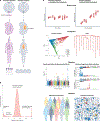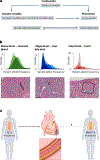Genetic variation across and within individuals
- PMID: 38548833
- PMCID: PMC11457401
- DOI: 10.1038/s41576-024-00709-x
Genetic variation across and within individuals
Abstract
Germline variation and somatic mutation are intricately connected and together shape human traits and disease risks. Germline variants are present from conception, but they vary between individuals and accumulate over generations. By contrast, somatic mutations accumulate throughout life in a mosaic manner within an individual due to intrinsic and extrinsic sources of mutations and selection pressures acting on cells. Recent advancements, such as improved detection methods and increased resources for association studies, have drastically expanded our ability to investigate germline and somatic genetic variation and compare underlying mutational processes. A better understanding of the similarities and differences in the types, rates and patterns of germline and somatic variants, as well as their interplay, will help elucidate the mechanisms underlying their distinct yet interlinked roles in human health and biology.
© 2024. Springer Nature Limited.
Conflict of interest statement
Competing interests
P.N. reports investigator-initiated grants from Amgen, Apple, Boston Scientific, Novartis and AstraZeneca; personal fees from Allelica, Apple, AstraZeneca, Blackstone Life Sciences, Foresite Labs, Genentech and Novartis; scientific board membership for Esperion Therapeutics, geneXwell and TenSixteen Bio; and spousal employment at Vertex, all unrelated to the present work. P.N. is a scientific co-founder of TenSixteen Bio, which is a company focused on clonal haematopoiesis but had no role in the present work. The other authors declare no competing interests.
Figures






References
-
- Lynch M et al. Genetic drift, selection and the evolution of the mutation rate. Nat. Rev. Genet. 17, 704–714 (2016). - PubMed
-
-
Coorens THH et al. Extensive phylogenies of human development inferred from somatic mutations. Nature 597, 387–392 (2021).
In this study, clones from many different normal tissues are sequenced, and phylogenetic trees of these normal cells are reconstructed, revealing embryonic lineages and somatic evolution.
-
-
- Spencer Chapman M et al. Lineage tracing of human development through somatic mutations. Nature 595, 85–90 (2021). - PubMed
Publication types
MeSH terms
Grants and funding
LinkOut - more resources
Full Text Sources

